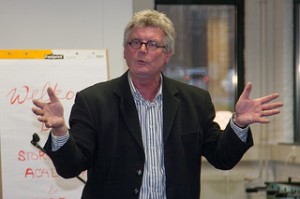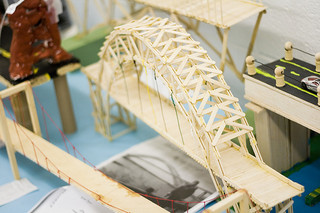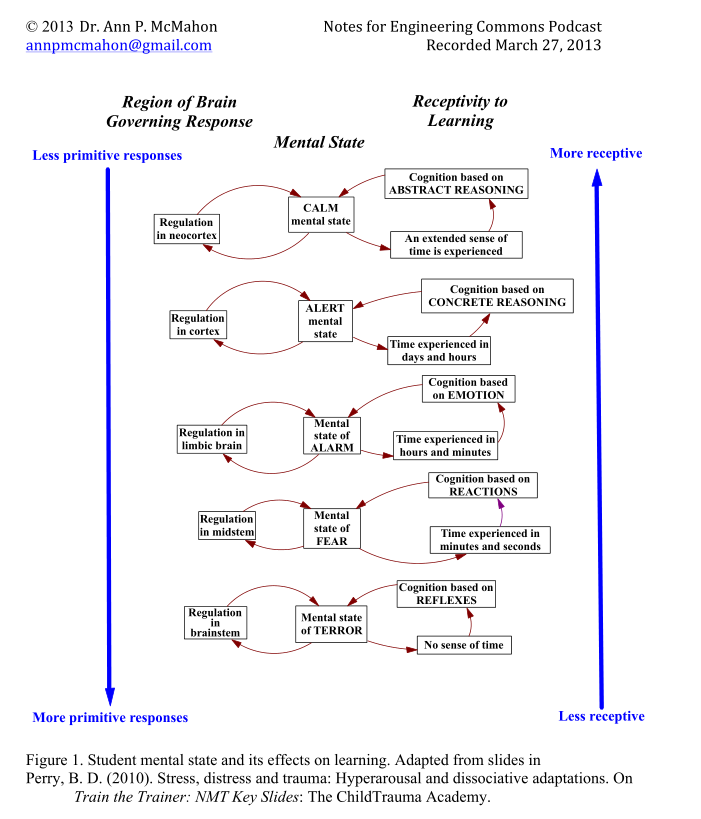Podcast: Play in new window | Download
Subscribe: Apple Podcasts |
 We talk with mechanical engineer, product designer, educator, and executive consultant Craig Sampson about the importance of storytelling in this episode of The Engineering Commons podcast.
We talk with mechanical engineer, product designer, educator, and executive consultant Craig Sampson about the importance of storytelling in this episode of The Engineering Commons podcast.
- Carmen likes the universality of engineering stories, in that all engineers eventually encounter similar difficulties in dealing with customers, managers, and organizations.
- In a prior episode of this podcast, guest Bob Schmidt talked about the importance of stories in conveying information about problem-solving methods and approaches.
- Our guest for this episode is Craig Sampson, who is founder and principle consultant for TBD Innovation.
- Jeff and Craig were classmates at Stanford University in the early 80s, while both were taking the Smart Product Design (ME 218 A/B/C) sequence of classes.
- Craig was good at math and science in high school, so he gave engineering a try at the University of Colorado.
- Jeff and Craig joke about programming in FORTH during their Stanford days.
- Larry Leifer led the Smart Product Design program during the time that Craig and Jeff were students.
- Craig has fond memories of watching a robot arm that performed ballet-like movements to the music of Trois Gymnopédies, composed by Erik Satie.
- Also on the Stanford campus at the same time as Craig and Jeff was David Kelley, the founder of Hovey-Kelley Design, which later became David Kelley Design (DKD) and eventually merged with two other firms to form IDEO in 1991.
- Craig started the IDEO office in Chicago, which now employs more than 60 designers.
- Paul Rand designed the original IDEO logo, which saw various alterations over the years.
- Craig finds the term human-centered design (video) preferable to design thinking.
- Our guest references a book by Tom Kelley (brother of David Kelley), The Art of Innovation: Lessons in Creativity from IDEO, America’s Leading Design Firm.
- Joseph Campbell outlined the classic “hero’s tale” in his book, The Hero with a Thousand Faces.
- Storytelling is the process of making your engineering work relevant in the lives of others, according to our guest, by presenting a believable vision of a better future.
- A good book for understanding service design and innovation is Scott McCloud’s book, Understanding Comics: The Invisible Art.
- Craig is a Senior Fellow at Farmhouse, the Innovation Center for advertising leader Leo Burnett.
- Our guest mentions the book, Winning the Story Wars: Why Those Who Tell (and Live) the Best Stories Will Rule the Future.
- According to the drawing by Hugh MacLeod, “The market for something to believe in is infinite.”
- Craig recommends the Dan Pink book, A Whole New Mind: Why Right-Brainers Will Rule the Future, to engineers who think there must be more to life than the daily grind.
- Personas are fictional characters that are imagined using a product or service.
- Our guest has started a class at Northwestern University, within the Segal Design Institute, called “Designing Product Interactions.”
- An influential book on addressing human expectations is Don Norman’s Design of Everyday Things.
- Our ability to integrate visual and auditory information is pushed beyond its limit by the McGurk Effect (YouTube video).
- Pareidolia describes human perception of a random stimulus as being significant; this is a form of apophenia.
- Synesthesia is the phenomenon that occurs when stimuli normally associated with a single sense activate a secondary sense, such as sensing that numbers have colors, or words have tastes.
- Craig notes that our confidence in a product is completely intertwined with our confidence in ourselves.
- It is increasingly the case that designers are creating tools, rather than products, for their customers.
- SketchChair allows people to sketch out the profile of a chair, which is then delivered as a set of cross-sectional cutouts that can be assembled.
- Skeumorphism is the use of a stimulus that is referential to other products or experiences.
- Jeff mentions the Dan Saffer book, Microinteractions: Designing with Details.
- Our guest encourages all engineers to think about how their work might positively impact the experiences of others.
- Craig can be reached at TBD Innovation.
Thanks to René Wouters for the photograph titled “Storytelling Academy #IEDP-42.” Podcast theme music by Paul Stevenson.
Podcast: Play in new window | Download
Subscribe: Apple Podcasts |
 Brian and Jeff talk with Ann McMahon about sharing one’s passion for engineering with pre-college students.
Brian and Jeff talk with Ann McMahon about sharing one’s passion for engineering with pre-college students.
- Brian has experienced the glassy-eyed look of others listening to his engineering stories.
- Our guest for this episode is Ann McMahon, an aerospace engineer who advises educators on how best to share science and engineering with K-12 students.
- Ann originally wanted to be an astrophysicist, but ended up in the aerospace industry after acquiring degrees in mechanical engineering.
- After a career with McDonnell Douglas, our guest started volunteering in her son’s classroom; this led to an interest in educational matters.
- For the past decade, Ann has been working with the Smithsonian Institution’s National Science Resources Center as a National Faculty member for a program called Leadership Assistance for Science Education Reform (LASER).
- Some existing programs for introducing engineering into the classroom include Project Lead the Way, and Engineering is Elementary.
- Brian wonders if engineering will ever be taught as its own subject; Ann is hopeful that schools are moving their curricula in this direction.
- “Wicked” problems are complex issues that have no “right” or “wrong” answers; and each possible solution presents even more potentially unforeseen consequences.
- In comparison, “tame” problems are definitively right or wrong, and lack the complexity of real-world issues.
- Having right or wrong answers, rather than evaluating tradeoffs, misses the essence of the engineering profession.
- It will likely take time for educators to determine how to assign grades in the absence of easily-defended solutions.
- An effort is being made in many classrooms to emphasize non-cognitive skills, such as collaborating, taking on the perspectives of others, arguing from evidence, and getting along with other team members.
- Susan Cain has recently released her book, Quiet: The Power of Introverts in a World That Can’t Stop Talking.
- The concept of an “object world” is introduced in Designing Engineers by Louis L. Bucciarelli.
- Ann recently gave a TEDx talked titled Engineering Empathy (use password tedxgladstone).
- We learn best when we are supported by relationships with important others who help us stretch to master new challenges and cope with potentially overwhelming situations.
- Relationships that a child has with a teacher and peers at school are influenced by the child’s earlier experiences.
- Our ability to learn is influenced by our mental state, as indicated in the following diagram.

- Ann believes that engineering offers unique opportunities for students to acquire important cognitive and social skills, including a chance to practice emotional regulation.
- Design competitions are great for some students, but others may not thrive in such an environment.
- Sharing what we know, at an appropriate level, is the best way to convey our interest in engineering with students.
- Ann can be reached at annpmcmahon *at* gmail.com; or found online at AnnPMcMahon.com.
Thanks to PiK Yeoh for the photo titled “Child-craft.” Podcast theme music provided by Paul Stevenson
Podcast: Play in new window | Download
Subscribe: Apple Podcasts |
 Chris and Jeff discuss why engineers are sometimes seen as cold, heartless bastards who refuse to be team players. Oh yeah, and how that might be linked to a lack of empathy.
Chris and Jeff discuss why engineers are sometimes seen as cold, heartless bastards who refuse to be team players. Oh yeah, and how that might be linked to a lack of empathy.
A recent journal article claims that engineering students have less empathy than students in other fields of study. Chato Rasoal, Henrik Denielsson & Tomas Jungert (2012): Empathy among students in engineering programmes, European Journal of Engineering Education, 37:5, 427-435.
Our guest for this episode is Jim Heilman, who appeared previously in our episode on recruiting. He thinks that the whole empathy thing with engineers is a perception problem.
Employers don’t usually ask about empathetic skills when looking for technical personnel, although the ability to “listen” is considered important.
On the whole, women are more empathetic than men, and empathy tends to increase with age and level of education.
We also tend to more empathetic toward those that share cultural and geographical backgrounds. Thus, we may have to work at being sufficiently empathetic towards those with different values and traditions.
Jim believes employers assume all candidates to be sufficiently empathetic, even through the evidence would indicate otherwise.
Taking candidates out to lunch is a common ploy to see how potential employees treat others, especially those who are not in positions of authority.
Chris recalls a quote by Samuel Johnson, “The true measure of a man is how he treats someone who can do him absolutely no good.”
A study out of Case Western Reserve University indicates that firing up the neuron network we use for empathy causes our analytic abilities to be suppressed. Anthony I. Jack, Abigail Dawson, Katelyn Begany, Regina L. Leckie, Kevin Barry, Angela Ciccia, Abraham Snyder. fMRI reveals reciprocal inhibition between social and physical cognitive domains. NeuroImage, 2012
Chris wonders what the biological advantage might be in this trade off between empathy and analysis.
Jim has noticed that women seem expected to show more empathy than men, especially by other women.
A recent Forbes article detailed an interview with author Jon Ronson. In his book, The Psychopath Test: A Journey Through the Madness Industry, Mr. Ronson notes that about 4 percent of CEOs display signs of psychopathy, four times the incidence found in the population at large.
Jeff recalls reading Thick Face, Black Heart: The Warrior Philosophy for Conquering the Challenges of Business and Life. It talked about the importance of having certain professionals, such as surgeons, be emotionally distanced from their patients.
A ranking of psychopathy incidence by profession shows CEOs leading the list, followed by lawyers, media personalities, salespeople, and surgeons.
There seems to be a gap between the knowledge skills and characteristics that a graduate engineer is expected to hold, and what skills and characteristics these engineers actually have.
Jim feels that engineers may be getting unfairly criticized, as a lack of empathy seems widespread in a number of industries.
Today’s college students display less empathy than previous generations.
In Steven Covey’s book, the Seven Habits of Highly Effective People, the fifth habit is “Seek First to Understand, Then to be Understood.”
Chris and Jim debate the need for empathy in the field of engineering.
Jim has found that sharing a meal with someone can lower tension in the workplace.
Engineering parents are twice as likely as non-engineering parents to have autistic children.
When we pay attention to the emotions of others, we start to mirror those emotions ourselves. This is the topic of the book, Mirroring People: The New Science of How We Connect with Others.
Steve Blank has written about developing empathic skills by emulating empathy.
The article about engineering students having a lack of empathy generated quite a bit of response on Reddit and Hacker News.
Listeners can review our podcast in iTunes!
Thanks to giveawayboy for the drawing titled “You unlocked all the channels in me.” Podcast theme music provided by Paul Stevenson
Practical insights for the engineering crowd
 We talk with mechanical engineer, product designer, educator, and executive consultant Craig Sampson about the importance of storytelling in this episode of The Engineering Commons podcast.
We talk with mechanical engineer, product designer, educator, and executive consultant Craig Sampson about the importance of storytelling in this episode of The Engineering Commons podcast.

